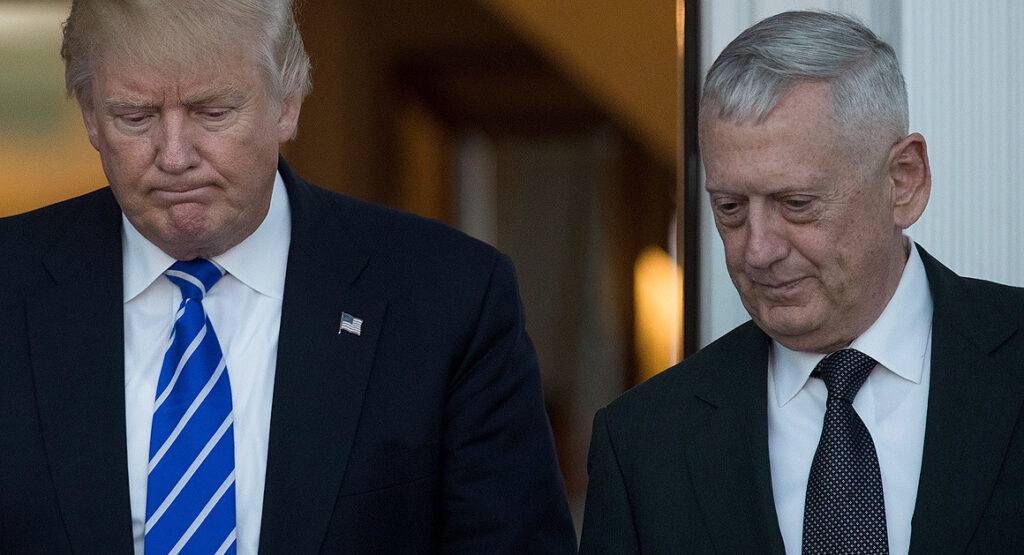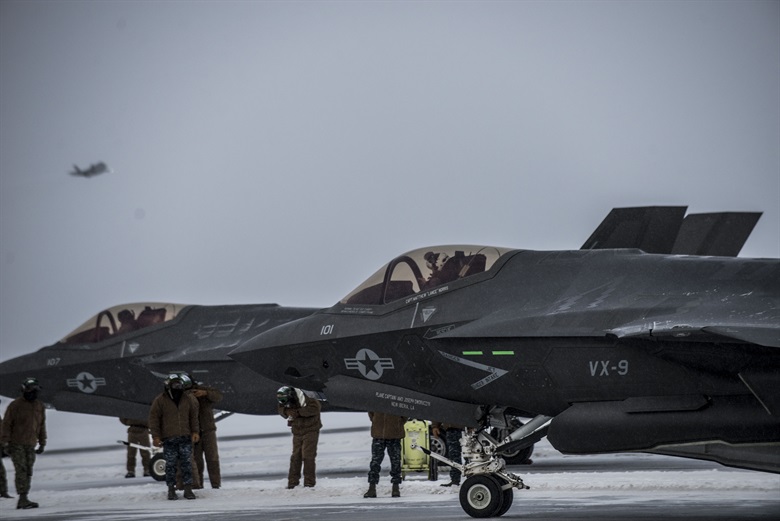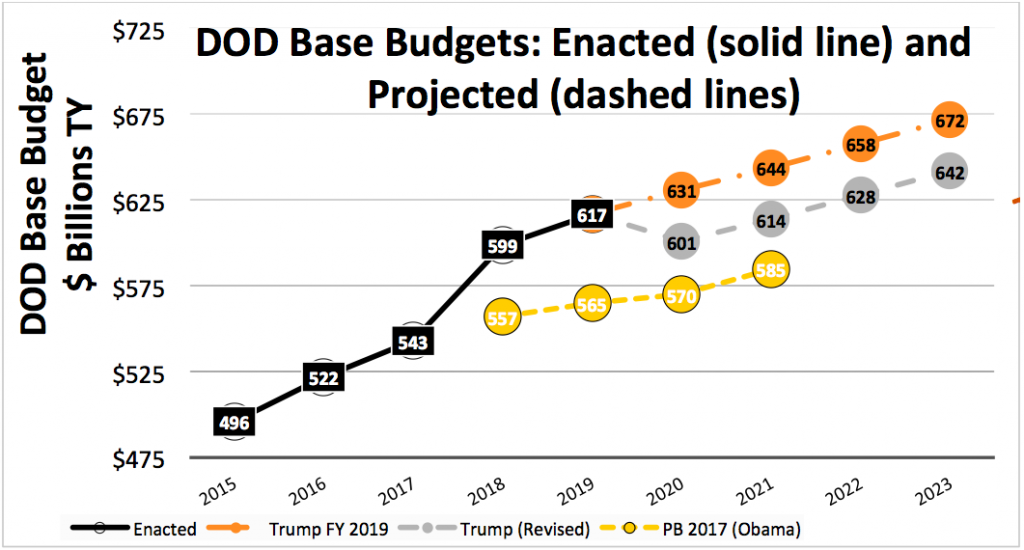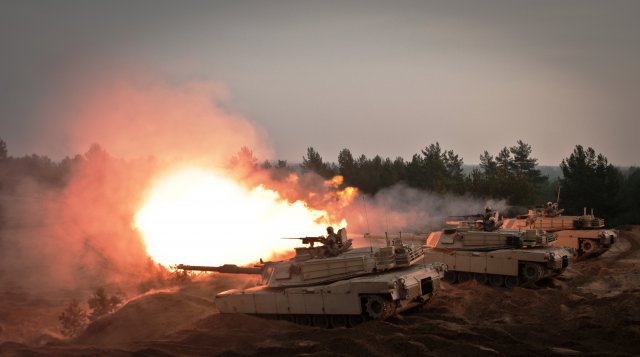President Trump and Defense Secretary Jim Mattis
 The good news about President Trump’s $30 billion cutback to defense? The Pentagon still has enough money to execute a national security strategy. The bad news? It’s enough to execute Obama’s strategy. Trump’s plan would undercut the more expansive National Defense Strategy for “great power competition” that embattled Defense Secretary Jim Mattis rolled out just nine months ago.
The good news about President Trump’s $30 billion cutback to defense? The Pentagon still has enough money to execute a national security strategy. The bad news? It’s enough to execute Obama’s strategy. Trump’s plan would undercut the more expansive National Defense Strategy for “great power competition” that embattled Defense Secretary Jim Mattis rolled out just nine months ago.
That President Trump is serious about reversing his much-touted defense buildup caught everyone in Washington by surprise, including the Mattis Pentagon, which had almost completed a $733 billion plan for 2020. Trump’s $700 billion figure would be five percent below the plan for 2020 and a 2.3 percent reduction from 2019, reversing the planned growth.
The defense world is still scrambling to figure out how the cut will impact programs and forces. Analysis using CSIS’s handy Force Cost Calculator gives some insights. The bottom line: there’s still a lot of money left, but the trade-offs get painful. If DOD wants to preserve readiness, which is its highest stated priority, then it must cut modernization, force structure, and troop benefits. It’s not clear that the administration could sustain its stated strategy after making such cuts. Here’s how it plays out.
Two F-35C fighters during pre-initial Operational Testing and Evaluation at Eielson Air Force Base, Alaska.
Show Me The Money
In the FY 2019 budget package, submitted last February, the Trump administration planned to request $701 billion for DOD in FY 2020: $631 billion for the base budget and $70 billion for Overseas Contingency Operations, assuming no OCO-to-base transfer. (OCO is not restricted by the Budget Control Act and is increasingly used as a work-around rather than genuine war spending).
The modern battlefield has become a complex theater of threats, from powerful anti-armor and anti-aircraft missiles to the dawn of small but lethal unmanned aircraft.
This $701 figure is for what’s called Budget Function 051.When added to $32 billion for nuclear activities in the Department of Energy and for national security activities in other departments, the total came to $733 billion for national defense writ large (Function 050).
Last week, the president made a confusing statement that seemed to indicate a cut of national security funding to $700 billion in FY 2020 to complement the five percent cut to domestic agencies. However, the president did not set this up with statements about waste or duplicative programs, and it contradicted his frequent rhetoric about building an unmatched military. The statement clearly surprised the Department of Defense and the Office of Management and Budget, which constructs the federal budget government-wide. They had been working off the earlier FY 2019 guidance.
Nevertheless, the president apparently meant what he said. The head of OMB, Mick Mulvaney, has directed DOD to build a second budget to this lower level.
Graphic by Mark Cancian, Center for Strategic & International Studies
The chart above shows what a cut of this magnitude looks like.
The solid line is the actual enacted budgets through FY 2019.
The top dashed line is what the Trump administration projected for DOD in the FY 2019 budget submission.
The line below that shows the revised guidance and assumes that the $30 billion cut continues through the five-year period. (Cutting $30 billion in FY 2020 and then returning to the previous guidance in FY 2021 would be highly disruptive and would not make much sense from a budget strategy perspective, and Deputy Secretary Paul Shanahan has said $700 billion would be the new baseline over the next five years.
The lowest line shows what the Obama administration had projected. The potential cut would, in effect, take out about half of the defense buildup.
M1 Abrams tanks of the 1st Cavalry Division fire during a NATO Atlantic Resolve exercise in Latvia.
What Might Get Cut?
What would a cut like this mean for defense programs and forces? CSIS has a budget tool, called the Force Cost Calculator, that takes 120 inputs for force structure, readiness, investment, infrastructure, and overhead and calculates the total budget. In making the calculation for forces, it includes all of the direct training and maintenance, as well as indirect support from other units and institutional overhead. Last summer the team updated the factors for the FY 2018 budget.
When the CSIS team sat down to find $30 billion in cuts, here’s the budget scenario that resulted:
Readiness maintained at the FY 2018 level (the last set of data in the tool). This preserves the gains that have been made over the last two years and acknowledges that readiness is Sec. Mattis’s top priority. That means, however, that other areas would have to take deeper cuts.
Regular Army frozen at 478,000 soldiers, about the level of 2016-2018, before the recent expansion. This would remove about half a Brigade Combat Team (leaving a reinforced battalion task force), freeze the number of new Security Force Assistance Brigades at two in the active-duty force (instead of the planned five), and remove some of the enhanced unit manning that has been added.
Navy ship buildup slowed. As a result, the fleet never reaches the 355-ship goal, which had already been pushed out to the 2050s. The fleet peaks at 326 in FY 2023 because of previously funded construction but then declines and stabilizes at about 310 (though that estimate depends on a lot of assumptions). Introduction of F-35Cs is also slowed.
Air Force acquisition of new aircraft slowed; about 100 legacy fighter/attack aircraft (A-10, F-15, F-16), 40 older tankers, and a dozen specialty aircraft retired, so the total force gets smaller. Bombers were unchanged since they are all being modernized. Drones were also unchanged as they are in such high demand for current operations.
Nuclear modernization takes a hit. The Columbia class cannot be further delayed lest there be a gap in coverage, but the B-21 bomber and ICBM replacement (Ground Based Strategic Deterrent) would slow down. The Long Range Standoff cruise missile would be terminated because there is an alternative in the B61 bombs.
Support activities like science and technology and military construction would be shaved.
New warfighting capabilities These advanced technologies — what the last administration called “the Third Offset Strategy” — are intended to better prepare for a conflict with a peer competitor like China or Russia. However, it will be difficult to make room for them in a declining budget. Some, like long-range precision munitions, are ready to field and would probably continue. However, major new weapon systems like the Army’s Next Generation Ground Combat Vehicle would likely be deferred. FY 2020 won’t be the “masterpiece” it was projected to be.
Pay raises constrained. The military pay raise would be reduced to 1.6 percent from the planned 2.1 percent and kept one-half percent below the target for the full five years. This would reduce the purchasing power of troop paychecks since inflation is expected to be about 2 percent. However, it saves a lot of money (about $500 million the first year and increasing after that) and can be justified since the forces will be reduced and the need to be competitive with compensation would ease.
Bad news for civil servants: no civilian pay raise in FY 2020 and reduced pay raises in future budgets. The Trump administration has proposed that before and will certainly propose it again.
Some cuts would need to begin immediately. There is no point, for example, in recruiting troops this year who would be discharged next year. Waiting too late to implement cuts would limit cuts to personnel and modernization and mean that readiness, which is easy to cut quickly, could not be spared.
The military’s geographical Combatant Commands (COCOMs).
Strategic Retreat
There is a fair argument that DOD would need to develop a new strategy because the lower budget could not support the National Defense Strategy that the department published last January. That strategy was very forward-leaning, calling for “a Joint Force that possesses decisive advantages for any likely conflict while remaining proficient across the entire spectrum of conflict.” It warned that “without sustained and predictable investment to restore readiness and modernize our military to make it fit for our time, we will rapidly lose our military advantage, resulting in a Joint Force that has legacy systems irrelevant to the defense of our people.” Other strategies are possible, even reasonable and desirable, but they are different and would require some easing of ambitions and expectations.
President Obama meets with his National Security Council. Trump’s proposed budget would fund Obama’s 2014 strategy — not the Trump Administration’s 2018 plan.
 The fact that the revised budget guidance is higher than the Obama administration projections is not comforting. The Obama administration changed its strategy after 2014, returning to Europe to counter Russian aggression, beginning an air war in Iraq and Syria to counter ISIS, and continuing its rebalance to the Pacific to counter an assertive China. However, the Obama administration did not change its budget projections, so that its new strategy was underfunded. The reduced Trump budget levels would allow the US to fully fund the Obama strategy from four years ago.
The fact that the revised budget guidance is higher than the Obama administration projections is not comforting. The Obama administration changed its strategy after 2014, returning to Europe to counter Russian aggression, beginning an air war in Iraq and Syria to counter ISIS, and continuing its rebalance to the Pacific to counter an assertive China. However, the Obama administration did not change its budget projections, so that its new strategy was underfunded. The reduced Trump budget levels would allow the US to fully fund the Obama strategy from four years ago.
It’s not clear that, in the end, Trump will be willing to make these kinds of changes. DOD will develop its alternative budget, present it to the president, and argue that it is unacceptable. The president might agree. Normally, OMB publishes decisions about agency top lines in a “passback” that is transmitted just before Thanksgiving. However, this year is so unusual and the cut so abrupt that the decision process might last past Thanksgiving and into December. A final decision must be made by the first week in January in order for the administration to publish the FY 2020 budget in the first week of February. Stay tuned. The battle is just beginning.




No comments:
Post a Comment